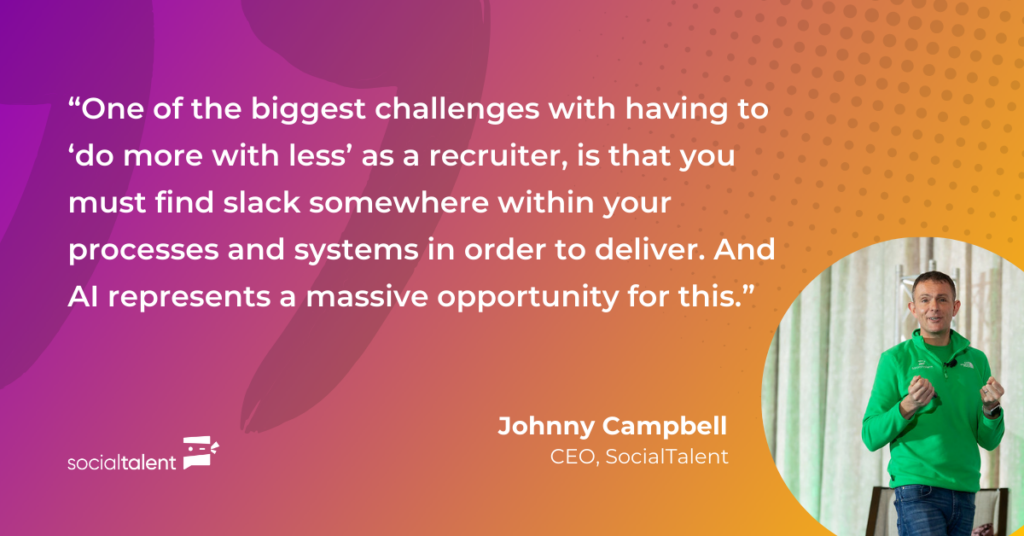
By Johnny Campbell
It’s not what you wanted to hear, right?!
I can understand the immediate frustration that recruiters would feel upon hearing a proclamation like this. Having to meet or exceed expectations with reduced headcount and resources is a tough ask to just accept. But the unfortunate truth is that we’re entering an era where it is simply becoming the norm to do more with less, regardless of the field you’re in.
I’m seeing it from a lot of customers right now, across the spectrum. For some, there’s a mandate to reduce TA teams but maintain or surpass output. Others are looking to gain more productivity from the processes they already have in place. It’s a commonality. And as much as it feels like recruiters could push against this narrative, I don’t think it will do much good. Why? Because the very nature of recruiting is going through a moment of transition, and I guarantee that we will not have the same volume, creating the same results, in 5 – 10 years.
So that leaves us trying to solve the thesis question – how does a recruiter do more with less? If this is indeed the reality we are contending with, what are the sustainable factors that will allow talent professionals to optimize?
Generative AI
It’s impossible to get through a think-piece about the future of recruiting without mentioning AI! One of the biggest challenges with having to ‘do more with less’ as a recruiter, is that you must find slack somewhere within your processes and systems in order to deliver. And AI represents a massive opportunity for this.
I was recently reading this fascinating report from McKinsey that predicts by 2030, Europe alone will require 12 million occupational transitions and up to 30% of working hours could be automated by AI. And while recruiting wasn’t a big enough industry to feature on their list, customer service and sales was – an area which mirrors the skills and standing of recruiting – and these roles themselves are set to decline by 12.1% over the next 5 years. It gives a glimpse into what the next stage of talent acquisition could look like, becoming more concentrated in terms of numbers, but still requiring results.
I spoke in a previous newsletter about how recruiters can start leveraging AI today in order to automate (and improve) various components of their roles. But I think the biggest issue we’re seeing right now seems to be around adoption. I was chatting with a customer recently and was told that despite rising expectations for their recruiters, 20% still hadn’t even tried Generative AI, and only 25% in total were regularly using it.
Generative AI has the potential to be a recruiter’s best friend and assist them in finding, hiring, and engaging with talent in a faster and more sustainable manner. But it will require a mindset shift and upskilling in order for it to truly take hold.

High Performance Teams
Outside of tech, the other most important avenue you must consider is to ensure that you are cultivating high performance teams. Recruiters that understand how to maximize their ability, show grit and perseverance, and know how to adapt and deliver on an increased ask need to become the standard in an environment of doing more with less.
There is a common misconception that the profile of a great recruiter is someone who just loves working with people. I completely disagree. Great recruiters are curious and inquisitive, they have a wide variety of interests, ask loads of questions, constantly seek knowledge, and aim to foster connections. If your recruiters are just a conduit for CVs and don’t add real value to the hiring process, you’re going to be in trouble very soon. Recruiters should be the difference-makers when it comes to making great hires.
High performance is when the team is doing something beyond just getting through volume. From innovating processes to be smoother to bringing key market knowledge to the table, if you have recruiters who care about their output and making an impact, you will inherently be able to create a culture of high performance.
What the Future Holds
Recruiters are incredibly resilient folk – we saw this during the pandemic, pivoting to different roles and responsibilities in order to remain vital. Their resolve will see them through this tough moment as well, I have no doubt about that.
But as an industry, recruiting is most definitely standing on the edge of a cliff right now with a very strong breeze behind it. Of course no one is thrilled with the idea of having to do more with less, but it’s a sink or swim moment and those who are willing to take the plunge, do the hard graft, and transform their approach will be all the better as a result.
Staying as you are, perched precariously on the edge and opting instead for inaction, will see you fall massively behind your competition. And sometimes pressure to innovate can give you the focus you need to make tough but necessary actions. I will always think back to the pandemic – we had to make some very difficult decisions around headcount in SocialTalent, but by looking at ways to optimize, we were able to double our revenue with a team that’s almost 20% smaller even now than pre-COVID.
And we see it in the news almost daily. Recruitment jobs are being slashed, budgets are being cut, TA teams are downsized, but the increased need for talent isn’t going anywhere. Recruiting will have to become leaner and more effective, and it’s through AI and high performance cultures that this can be achieved.
Share Your Thoughts
I want to hear from the industry – are you experiencing this demand to do more with less? What ways have your teams optimized? Have there been any benefits for having to focus and be more disciplined with resources?


